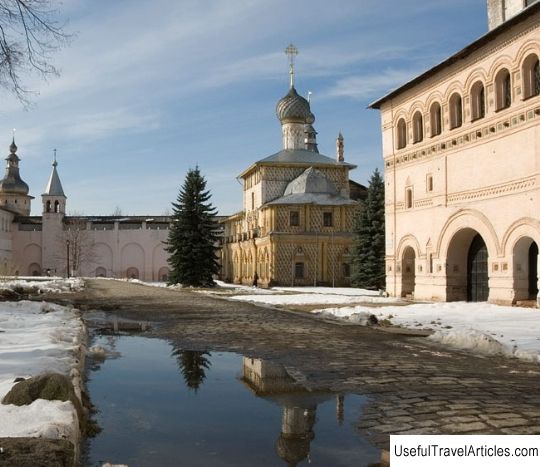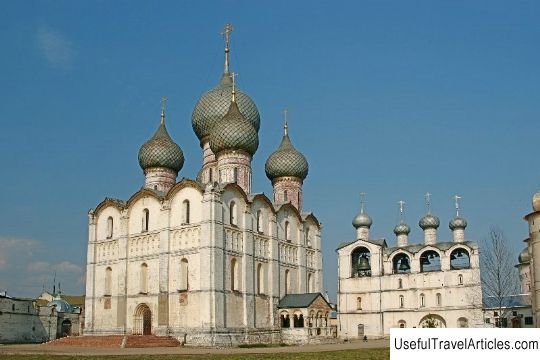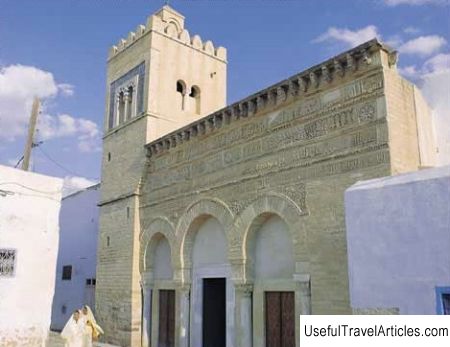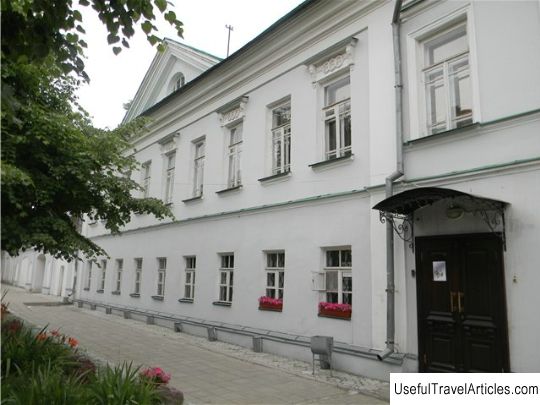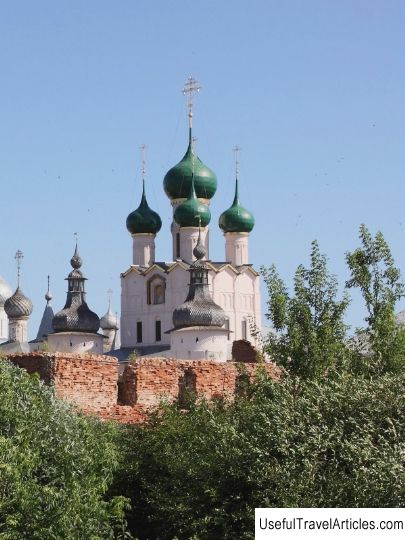Rostov Kremlin description and photo - Russia - Golden Ring: Rostov the Great
Rating: 8,5/10 (4895 votes) 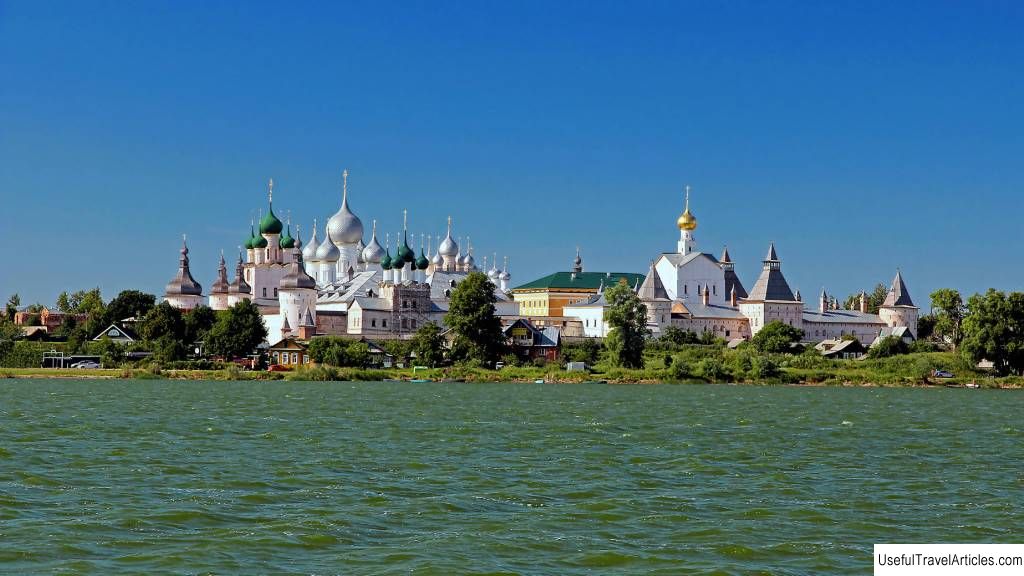
Rostov Kremlin description and photos - Russia - Golden Ring: Rostov the Great. Detailed information about the attraction. Description, photos and a map showing the nearest significant objects. Photo and descriptionThe huge complex of the Rostov Metropolitan Court was built in the 17th century as the residence of the Rostov bishops. It has been preserved almost completely unchanged: walls and towers, several churches, ceremonial residential buildings and outbuildings. Now it houses the rich museum expositions of the Rostov Museum-Reserve. Assumption CathedralThe most ancient structure of the architectural ensemble of the Kremlin, and in general the oldest building in the city of Rostov the Great is the Assumption Cathedral. The temple itself on this site has existed since the XII century, the present cathedral was built in 1508-1512, not from white stone, but from brick. White stone (including those left over from the previous building) was used to create decorative elements. One fragment of the previous buildings has survived on this site - now it is the "underground" Leontief side-chapel, it is located much lower than the current floor level. It was built over the burial of St. Leonty Rostovsky, the first Christian missionary in these places, killed by pagans in the 1070s. The Assumption Cathedral is a classic five-domed temple with a zakomarny covering. In 1587 Rostov became the center of the diocese, the cathedral became the cathedral and the bishop's burial vault. A new porch-porch is attached to it, and the domes from the helmet-shaped ones become bulbous. In 1754, the roof of the cathedral was remodeled, and the front holy gate was erected in front of it. In the 18th century, the old iconostasis was dismantled and replaced with a new one, made in the Baroque style. The cathedral was renovated at the beginning of the 19th century, then it underwent a significant restoration in the 50s of the XX century. During the restoration, several fragments of murals from the 12th century were found, and some of the surviving frescoes of the 16th-17th centuries, but the bulk of the murals were made in 1843. Now the cathedral has been transferred to the church and is slowly being restored from the inside. Metropolitan Court The main complex of buildings was created in 1650-1680. This was the grandiose plan of the metropolitan court, the residence of the bishops, the prototype of which is the Heavenly Jerusalem. The customer was Metropolitan Iona Sysoevich , protege of Patriarch Nikon. His name is associated with a huge construction throughout the diocese - he renovated many churches and monasteries. Under him, the art of casting bells flourished in Rostov, and the famous Rostov bells appeared. In 1682, on his order, a belfry was attached to the Assumption Cathedral, and the Church of the Lord's Entry into Jerusalem was built in its lower tier. Bells for the belfry are cast by the best craftsmen. The largest bell, weighing two thousand poods, is called by the Metropolitan "Sysoy" in memory of his father. In total, there were 13 bells on the belfry, and since the beginning of the 19th century - 15, 9 of them have their own names. At the end of the 17th century, the diocese bought off a huge sum from Peter I, who seized the bells in order to pour them into cannons - the Rostov bells survived. They survived in Soviet times - in 1966 "Melody" even released a disc with their ringing. The Metropolitan Court, which is now called the Rostov Kremlin, was built on the shores of Lake Nero. There are 11 towers on the walls. It was a fortress-in-a fortress: in 1632-34 the center of Rostov was surrounded by walls of an earthen fortress and ditches, its remains are well preserved and can be seen. The stone Metropolitan courtyard is located inside the city's earthen fortifications. Although the walls and towers of the Metropolitan's Court were built according to the rules of fortification, they were richly decorated and intended more to demonstrate the greatness of spiritual power than for real defense - they never participated in any military operations. Now you can walk along the walls and towers, and on one of the Kremlin's towers - the Water Tower - there is a observation deck , from which a magnificent view of Rostov opens. Under the walls of the Metropolitan's Court on the shore of the lake, the Metropolitan Garden was laid out in the form of a cross, planted with fruit trees - now it is being revived by the museum. The Holy Gates with the gate of the Resurrection Church led to the Metropolitan Court. It has preserved paintings of the 18th century, in the creation of which the artel of the famous icon painter Gury Nikitin probably took part. The second gate church - John the Theologian is a little later and more solemn, surrounded by galleries and turrets. It also contains ancient frescoes. For himself, Metropolitan Jonah is building a house church of the Savior Not Made by Hands . Later it was called the Church of the Savior on the Seny: the church is located on the upper floor of the premises, and the lower parts are occupied by the refectory and outbuildings; it was connected with the Metropolitan's mansions by galleries. It has preserved the paintings of 1675 (the Last Judgment fresco and the painting on the dome), as well as the iconostasis. The names of icon painters are known - Dmitry Grigoriev, Fedor and Ivan Karpov. All three churches and their paintings are part of the museum exposition. Almost immediately the Judgment Order - the main administrative building of the diocese - and the Metropolitan Mansion were built. In the Metropolitan Manor (Samuil's Corps) the bishop himself lived and the treasury was kept. They have come down to our time in a significantly rebuilt form: their first floor was built in the 16th, and they received their modern look already in the 18th. Now it houses an exposition of ancient Russian art - icon painting and facial embroidery of the 16th-17th centuries, created by Rostov masters. The second building - Red or State mansions - two-story ceremonial chambers, built on the model of Moscow royal palaces. They were also rebuilt, but now they are restored to their original forms. Now they house an exposition dedicated to the history of Rostov the Great: archaeological finds from the Paleolithic period, documents, architectural fragments and part of the utensils of the Assumption Cathedral. There is also a virtual multimedia exhibition dedicated to the funds of the Rostov Museum. The one-pillar White Chamber was built for solemn bishop's dinners. Now it houses the Museum of Church Antiquities - here are collected masterpieces of decorative and applied art of the 17th-18th centuries. The history of the Rostov museum dates back to 1883, when, at the initiative of the Rostov merchants and the Yaroslavl governor V. Levshin, a museum was created based on the treasury of the bishop's house. In the entrance hall of the White Chamber there is an exhibition of kitchen utensils dating back to the 10th century. Church of St. George the Theologian is located on the site of the former Grigorievsky Monastery and repeats the silhouettes of the more magnificent churches of the complex, but devoid of rich external decor. It has preserved the baroque stucco molding of the 40s. XVIII century, iconostasis and murals of the late XIX century. Church of Hodegetria , the latest building of the complex, was built in 1692. It now houses the exhibition "Treasures of the Rostov Kremlin." The Kremlin is home to the Museum of Rostov Enamel , which presents items with enamel from the 18th to the 20th centuries, from icons to portraits of Stalin and a branded store where you can buy modern products from the enamel factory. The Pantry Chamber houses an open storage of archaeological funds, accessible only with guided tours several times a week. In the next building there is a bell art center . Here you can see a collection of church bells and bells, there is a cinema hall and a library, and they can tell in detail about the technologies of bell casting and Rostov ringing. In addition, now a modern hotel is set up in the 18th century utility rooms. History of restoration Renovation of the Rostov Kremlin in Soviet times became one of the largest projects of national restoration. After the revolution, the churches were closed, some of the territories were transferred to the museum, some to institutions, and the utility buildings were just for housing. The city was lucky - nothing was demolished here, but the buildings were dilapidated and fell into decay. In 1953, a strong tornado hit the city, the churches lost their domes and roofs - and the question arose about the need for repair. The ancient frescoes run by the museum were under threat. It was decided not just to renovate the buildings, and if possible, return the complex to its original architectural appearance, removing the restructuring of the 18th-19th centuries. The restoration was carried out according to the project and under the leadership of V.S. Banige. The four-pitched roof of the Assumption Cathedral was replaced with the original pozakomarnoe covering, the original form of the 17th century was returned to most of the residential and utility buildings and churches. Now the Rostov Kremlin is a textbook example of an ideal scientific restoration of a large complex, made in a single style.              We also recommend reading Villa Forni Cerato description and photos - Italy: Vicenza Topic: Rostov Kremlin description and photo - Russia - Golden Ring: Rostov the Great. |

